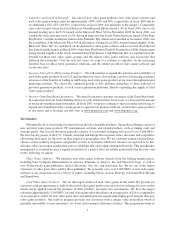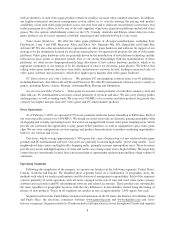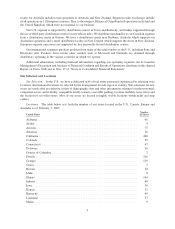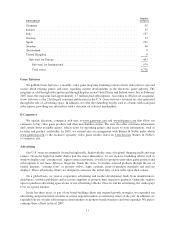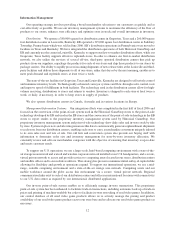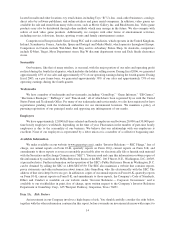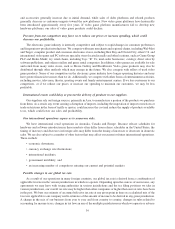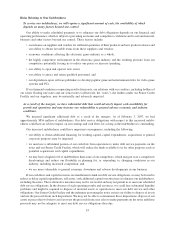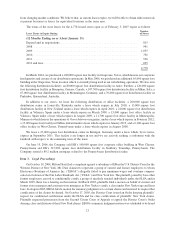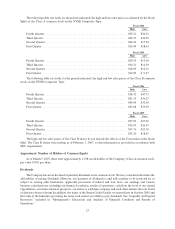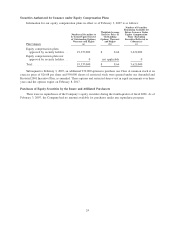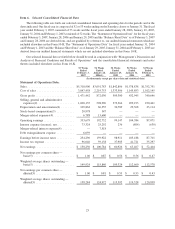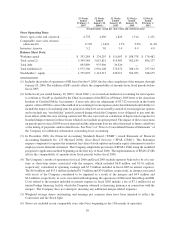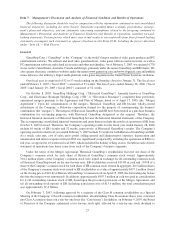GameStop 2006 Annual Report Download - page 32
Download and view the complete annual report
Please find page 32 of the 2006 GameStop annual report below. You can navigate through the pages in the report by either clicking on the pages listed below, or by using the keyword search tool below to find specific information within the annual report.outcomes from the tax audits that regularly are in process in any jurisdiction in which we operate could result in an
unfavorable change in our overall tax rate, which could have a material effect on our business and results of our
operations.
If we are unable to renew or enter into new leases on favorable terms, our revenue growth may decline.
All of our retail stores are located in leased premises. If the cost of leasing existing stores increases, we cannot
assure you that we will be able to maintain our existing store locations as leases expire. In addition, we may not be
able to enter into new leases on favorable terms or at all, or we may not be able to locate suitable alternative sites or
additional sites for new store expansion in a timely manner. Our revenues and earnings may decline if we fail to
maintain existing store locations, enter into new leases, locate alternative sites or find additional sites for new store
expansion.
The ability to download video games and play video games on the Internet could lower our sales.
While it is currently only possible to download a limited amount of video game content to the next generation
video game systems, at some point in the future this technology may become more prevalent. A limited selection of
PC entertainment software and older generation video games is currently available for download over the Internet.
If advances in technology continue to expand our customer’s ability to access software through these and other
sources, our customers may no longer choose to purchase video games or PC entertainment software in our stores.
As a result, sales and earnings could decline.
If we fail to keep pace with changing industry technology, we will be at a competitive disadvantage.
The interactive entertainment industry is characterized by swiftly changing technology, evolving industry
standards, frequent new and enhanced product introductions and product obsolescence. These characteristics
require us to respond quickly to technological changes and to understand their impact on our customers’
preferences. If we fail to keep pace with these changes, our business may suffer.
An adverse trend in sales during the holiday selling season could impact our financial results.
Our business, like that of many retailers, is seasonal, with the major portion of our sales and operating profit
realized during the fourth fiscal quarter, which includes the holiday selling season. During fiscal 2006, we generated
approximately 43% of our sales and approximately 67% of our operating earnings during the fourth quarter. Any
adverse trend in sales during the holiday selling season could lower our results of operations for the fourth quarter
and the entire year.
Our results of operations may fluctuate from quarter to quarter, which could affect our business, finan-
cial condition and results of operations.
Our results of operations may fluctuate from quarter to quarter depending upon several factors, some of which
are beyond our control. These factors include:
• the timing and allocations of new product releases;
• the timing of new store openings; and
• shifts in the timing of certain promotions.
These and other factors could affect our business, financial condition and results of operations, and this makes
the prediction of our financial results on a quarterly basis difficult. Also, it is possible that our quarterly financial
results may be below the expectations of public market analysts.
Our failure to effectively manage new store openings could lower our sales and profitability.
Our growth strategy is largely dependent upon opening new stores and operating them profitably. We opened
421 stores in fiscal 2006 and expect to open approximately 500 to 550 new stores in fiscal 2007. Our ability to open
17


